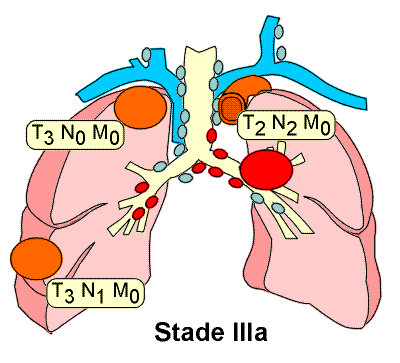Lung cancer forms when a number of abnormal cells start to uncontrollably reproduce, disrupting the processes at work in your lungs, infect other tissues surrounding it, and eventually grow lethal tumors in your body.
Stage 3 lung cancer, or non-small cell lung cancer, is considered locally advanced, which means the tumor most likely has expanded past the lungs. This usually means that the cancer has spread into the wall of the chest, into the diaphragm, or even into the lymph nodes in the neck which are farthest from the lungs. The lymph nodes of someone with this stage of lung cancer are always found on the side where the tumor is located.

Stage 3 A Lung Cancer
T1 – T3, N2, M0
With T1 you could have a tumor that is smaller than 3 centimeters all the way to 7 centimeters.
The growth of the cancer has not progressed to the middle are of the lungs, any of the major blood vessels that are located close to the heart itself, the heart itself, the esophagus, the trachea, the backbone or the carina. The carina is the space that divides the area to the left and right main stems of the bronchi.
There has been no further progression into the nodes located in the carina area or around the lungs.
The cancerous tumor hasn’t spread to other lobes located in the affected lung.
The cancer hasn’t spread to other organs in the body.
T3, N0, N1, M0
Symptoms of the third stage of 3 A of this form of cancer include an expansion into the nodes that are located in the lung as well as the bronchus area that unites the lungs. The nodes can be found on the side where the cancer is located, and there is no progression to other distant organs. You may experience any of the symptoms listed below:
A tumor that is bigger than 7 centimeters.
The disease has spread to the wall of the chest, the membranes that are located between the diaphragm, the lungs and the area that encompasses the heart.
The disease has expanded to the primary bronchus and has spread to around 2 centimeters around the carina. Even though it is close it has not spread to the carina.
The airways have been blocked and may cause the lung to shut down or become worsened.
There are more than one different tumors located in the same area of the lung that is affected.
T4, N0 or N1, M0
During this stage of the cancer, the disease has not made it to any distant organs. In the N1 versus the N0 stage it is possible that the tumor could advance to the lungs as well as where the lungs and the bronchus meet.
You may also experience any of these characteristics as well:
A tumor that could be any size may have developed in the area that is around the lungs, near the heart, around any major blood vessels, close to the trachea, or the carina, backbone or esophagus.
There may be separate tumors located in the different areas of one of the lungs.
Stage 3B Lung Cancer
Any T, N3, M0
The tumor is of a nonspecific size.
The lungs may have collapsed or they may have pneumonia or some other type of inflammation.
The disease has advanced to the collarbone and the lymph nodes that are on both sides or the nodes that are located on the other side of the primary polyp.
T4, N2, M0
The existing tumor has advanced to the area of the lungs, trachea, and blood stream around the heart, backbone, esophagus, or the bronchi.
More than one tumor is present in other areas of the lung.
The disease has advanced to the carina and bronchi area.
The lymph nodes that are affected can be found on the side where the primary tumor can be found.
Progressing Symptoms of Stage 3 Lung Cancer
Though early stages of lung cancer may produce no visible symptoms, there are many other noticeable symptoms, such as a new, persistent, and lingering cough that produces more mucus and blood than regularly.
Other symptoms include pain in the chest area, wheezing sounds when you’re breathing, unexplained weight drops, bone pains, and trouble breathing, all of which could point to you developing lung cancer.
Treatment for Stage 3 Lung Cancer
Treatments available for stage 3 non-small cell lung cancer (NSCLC) include surgery, chemotherapy (chemo), and radiation therapy, alone or combined together. Treatment for stage 3 lung cancer relies on the severity of the cancer, the extent to which a patient can tolerate the treatments, also factors in the patient's lung condition and lifestyle.
For patient in a relatively good condition may undergo chemotherapy (chemo) together with radiation therapy. After that, the doctor will decide whether or not to have a surgery based on the possibility of the removal of remaining cancer and a patient's health condition. (Sometimes surgery may be the first treatment.) And radiation or chemo alone may be applied for patients who cannot tolerate the combination of treatments.
As the cancer is not easy to cure, so it might be a good option to consider a clinical trial of newer treatments.
If you smoke, the most essential thing you can do is stop and quit smoking. Many studies have shown that those who did quit smoking had a higher chance to succeed in the operation.
Video
More about stage 3 lung cancer


View All Comments /Add Comment